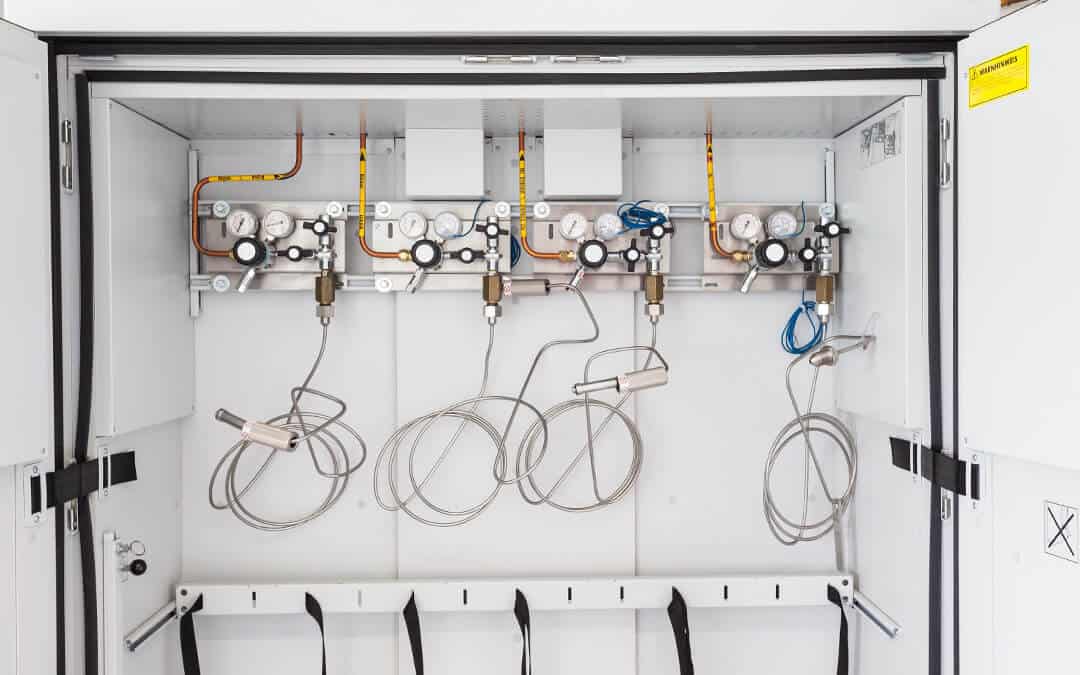Cylindrical containment vessels are used to store gases at pressures above atmospheric, or barometric, levels. These elongated cylinders are designed to stand upright, on a flat bottom – with valves, regulators, and gauges attached at the top. Pressurized cylinder contents can be in the form of compressed, vaporized, or liquefied gas.
Depending on the properties of the gas, cylinder contents may be flammable, combustible, corrosive, toxic, or otherwise harmful to people (and objects) in the cylinder’s vicinity. When gas is pressurized, both the gas itself and its containment vessel can create a hazardous environment. Proper cylinder handling – including transport and storage – are essential to the safe use of pressurized gas.
Creating A Safe Environment For Cylinder Storage
Compressed gas cylinders should be stored – upright and secured with sturdy restraints – in dry, well-ventilated areas, with their contents (and hazard class) clearly marked. Gas identification is typically stamped or stenciled onto the cylinder – or on a label affixed (or otherwise attached) to the cylinder.

Cylinders should be stored where they’ll be protected from unnecessary jostling or impact. Securing cylinders in place – with straps, chains, or brackets – prevents them from accidentally tipping over, knocking into one another, or being moved by a seismic event. If a compressed gas cylinder falls over, its pressure-control valve could be damaged. If the valve is damaged, the pressurized gas could be released rapidly, turning the cylinder into a projectile – potentially causing property damage, injury, or death. A ruptured cylinder can also cause oxygen displacement, creating a toxic environment around the cylinder storage area.
Temperature is another important consideration for cylinder storage. Compressed gas cylinders should be stored at temperatures no higher than 125°F (52°C). Gas expands when it’s heated, which increases pressure in the cylinder – and this can lead to a malfunction. Within a cylinder’s main gas valve is a pressure relief valve. If external heat or fire causes the cylinder’s gas pressure to increase, the pressure relief valve releases some of the gas. This controlled release prevents pressure build-up, reducing the risk of explosion.
Keeping Cylinders Segregated And Secured
Cylinders containing flammable gases must be separated from cylinders containing oxidizers, such as oxygen – to lower the risk of combustion or explosion. Empty cylinders should also be kept separate from filled cylinders. Cages, racks, or partitions can be used to segregate cylinders of different types, for added protection.
When moving cylinders – for replacement, for servicing, for delivery and removal – they must be secured to specially designed transporting devices. Gas cylinders should never be rolled, dragged, or slid across the floor. Moving a cylinder even a short distance requires it to be strapped (or chained) to a cart – for safe transport.

Maintaining A Cylinder Supply
Gas cylinder installation and maintenance are to be carried out by only trained professionals. While well regulated and fairly easy to control, cylinder contents are compressed to very high pressures – as such, they must be handled with care and expertise, in environments not subject to excessive moisture, extreme temperatures, or regular foot traffic.
Cylinder valves should be opened slowly, to prevent rapid gas compression, which can damage the pressure regulator and valve seats. Tools for opening release valves are typically provided by the cylinder supplier. It is not recommended to attempt opening a cylinder valve with pliers or other tools not specified for use with cylinder valves.
When compressed gas cylinders are not being used, their valves and regulators should be closed. The valve is closed first, then the regulator. Closing the valve protects the cylinder contents from the surrounding atmosphere. It also keeps corrosive elements away from the valve (and regulator), and prevents contaminants from entering the cylinder. When gas administration is complete, and the valve is closed, a protective cap should be placed on the top of the cylinder, to protect its mechanical components.
Contact CalOx and leverage our years of experience – and expertise – to compressed gas cylinder delivery and service.
